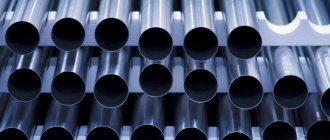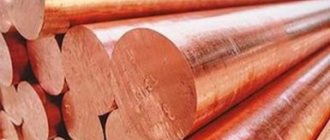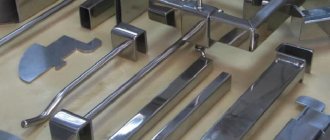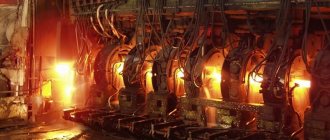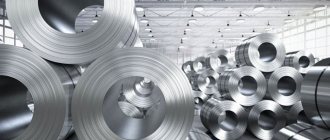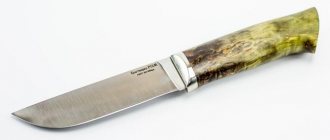Food grade stainless steel, as stainless steel is abbreviated to be used for the production of products that come into contact with food and liquids during their operation, is a material with a special chemical composition. The properties of this metal, represented by various grades, determine a fairly wide scope of its application.
Stainless steel sheet grade 08Х18Н10 (AISI 304) polished in film
Stainless steel marking for the food industry
Stainless steel products are imported to Belarus from Russia, China, EU countries and others, where the production of stainless alloys is regulated by internal standardization systems.
General information about stainless steels and alloys is not an alternative to the current regulatory and technical documentation (GOSTs and Technical Conditions) and is presented for general information. The table shows steel grades in accordance with GOST and their foreign analogues used for the production of stainless steel products, which fit the definition of “food grade stainless steel”.
The stainless steel marking system developed in the Soviet Union in accordance with GOST 5632-72 is used to designate brands by manufacturers in countries that are part of the CIS. The steel grade formula consists of alphanumeric characters, the letters indicate the chemical element in the alloy, and the numbers indicate its quantitative content.
Standards: AISI, ASTM, ASME, AMS are used by US manufacturers. The AISI classification of alloyed corrosion-resistant grades was developed by the American Steel and Alloy Institute. Stainless steel from Europe can be classified both according to the national standards of manufacturers (Germany, Austria, France, Italy, Poland) and according to the general standard of the European Union (European norm - EN 10088). Rolled metal manufacturers in Japan and China have their own standards for marking stainless steel.
The AISI and EN steels listed in the table correspond to their Russian counterparts in properties and are very similar in the chemical composition of the alloy.
| AISI USA | GOST Russia | EN 10088 |
| AISI 304 AISI USA | 08Х18Н10 GOST Russia | 1.4301 EN 10088 |
| AISI 316 AISI USA | 03Х17Н14М2 GOST Russia | 1,4401 EN 10088 |
| AISI 316L AISI USA | 03Х17Н14М3 GOST Russia | 1.4435 EN 10088 |
| AISI 316Ti AISI USA | 10Х17Н13М2Т GOST Russia | 1.4571 EN 10088 |
| AISI 321 AISI USA | 12Х18Н10Т GOST Russia | 1.4541 EN 10088 |
Chemical composition of AISI 304 and analogues
| Element | Item name | Compound |
| C Element | Carbon Element Name | up to 0.8% Composition |
| Si Element | Silicon Element Name | up to 0.8% Composition |
| Mn Element | Manganese Element Name | up to 0.2% Composition |
| Ni Element | Nickel Element Name | 9-11 % Compound |
| S Element | Sulfur Element Name | up to 0.02% Composition |
| P Element | Phosphorus Element Name | up to 0.035% Composition |
| Cr Element | Chrome Element name | 17-19 % Compound |
| Ti Element | Titanium Element Name | up to 0.5% Composition |
| Cu Element | Copper Element Name | up to 0.3% Composition |
| Fe Element | Iron Element Name | ~ 69 % Compound |
AISI 304 stainless steel belongs to the class of corrosion-resistant, heat-resistant steels. The temperature range in which AISI 304 steel can be used without changing the basic properties is from -196 to +600 °C. Hardening of AISI 304 stainless steel is carried out at a temperature of 1020 – 1100°C. Weldability of steel: without restrictions.
Chemical composition of AISI 321 and analogues
| Element | Item name | Compound |
| C Element | Carbon Element Name | up to 0.08% Composition |
| Si Element | Silicon Element Name | up to 0.8% Composition |
| Mn Element | Manganese Element Name | up to 2% Composition |
| Ni Element | Nickel Element Name | 9-11 % Compound |
| S Element | Sulfur Element Name | up to 0.02% Composition |
| P Element | Phosphorus Element Name | up to 0.035% Composition |
| Cr Element | Chrome Element name | 17-19 % Compound |
| Cu Element | Copper Element Name | up to 0.3% Composition |
| Fe Element | Iron Element Name | ~ 65 % Compound |
AISI 321 stainless steel has good weldability at higher temperatures than non-titanium steels. Welding seams require minimal post-processing.
Chemical composition of AISI 316 and analogues
| Element | Item name | Compound |
| C Element | Carbon Element Name | up to 0.03% Composition |
| Si Element | Silicon Element Name | up to 0.6% Composition |
| Mn Element | Manganese Element Name | up to 0.8% Composition |
| Ni Element | Nickel Element Name | 14-16 % Compound |
| S Element | Sulfur Element Name | up to 0.015% Composition |
| P Element | Phosphorus Element Name | up to 0.02% Composition |
| Cr Element | Chrome Element name | 15-17 % Compound |
| Mo Element | Molybdenum Element name | 2.5-3 % Compound |
| Fe Element | Iron Element Name | ~ 64 % Compound |
The presence of molybdenum in Aisi 316 stainless steel significantly increases its anti-corrosion properties, making operation possible even in very aggressive environments. Stainless steel AISI 316, 316L differs from steel 304 AISI in increased strength, resistance to creep, and excellent mechanical properties.
Chemical composition of AISI 316Ti and analogues
| Element | Item name | Compound |
| C Element | Carbon Element Name | up to 0.1% Composition |
| Si Element | Silicon Element Name | up to 0.8% Composition |
| Mn Element | Manganese Element Name | up to 2% Composition |
| Ni Element | Nickel Element Name | 12-14 % Compound |
| S Element | Sulfur Element Name | up to 0.02% Composition |
| P Element | Phosphorus Element Name | up to 0.035% Composition |
| Cr Element | Chrome Element name | 16-18 % Compound |
| Mo Element | Molybdenum Element name | 2-3 % Compound |
| Fe Element | Iron Element Name | ~ 61 % Compound |
| Ti Element | Titanium Element Name | up to 0.07% Composition |
The physical properties of AISI 316Ti stainless steel differ little from the properties of AISI 316 stainless steel; AISI 316Ti has greater strength due to the titanium present in its composition.
Mechanical properties of 12Х18Н10Т
| Section, mm | Section, mm | B, MPa | 0.2, MPa | 5, % | , % |
| Rods. Quenching 1020-1100 °C, air, oil or water. | 60 | 510 | 196 | 40 | 55 |
| The rods are ground and processed to a specified strength. | 590-830 | 20 | |||
| Hard-worked rods. | <5 | 930 | |||
| Stainless steel sheets, hot-rolled or cold-rolled. Quenching 1000-1080°C, water or air. | >4 | 530 | 236 | 38 | |
| Stainless steel sheets, hot-rolled or cold-rolled. Quenching 1050-1080°C, water or air. | <3,9 | 530 | 205 | 40 | |
| Stainless steel sheets, hot-rolled or cold-rolled, hard-worked | <3,9 | 880-1080 | 10 | ||
| Forgings. Quenching 1050-1100°C, water or air. | <1000 | 510 | 196 | 35 | 40 |
| Heat treated wire. | 1,0-6,0 | 540-880 | 20 | ||
| Seamless hot-deformed pipes without heat treatment. | 3,5-32 | 529 | 40 |
Food and non-food stainless steel, difference in alloy composition
To understand how food-grade stainless steel differs from ordinary non-food grade stainless steel, it is necessary to find out which elements affect the corrosion resistance of stainless metals.
The cheapest technical ferritic or chromium alloys are magnetic and have similar properties to low-carbon steel, but have higher corrosion resistance. The most common grades of ferritic stainless steel have a low carbon content, containing on average 11-17% chromium. These grades are resistant to corrosion during short-term contact with mildly aggressive environments.
Chromium Russian steel grades and their foreign analogues 08X13 (AISI 409), 12X13 (AISI 410), 12X17 (AISI 430) are used in the chemical and heavy industries, as well as in the manufacture of heating equipment. These steels are characterized by a combination of high strength and ductility, and are perfectly amenable to mechanical processing - plastic deformation, stamping.
Martensitic grades of stainless steel and their analogue according to the American classification - 20Х13, 30Х13, 40Х13 (AISI 420) are difficult to weld. Most often they are used to make springs, measuring and cutting tools.
The most common on the metal market are stainless chromium-nickel steels . Depending on the chemical composition of the alloying elements, they can have an austenitic, austenitic-ferritic and austenitic-martensitic structure. The properties of these stainless metals depend on the percentage of iron (Fe), chromium (Cr), nickel (Ni), molybdenum (Mo) and titanium (Ti) and other filler elements. Despite some qualitative differences, all of the steel grades listed below are used in food and processing plants.
How table stainless steel differs from other grades of steel
It should be said that there are no steel grades intended for use exclusively in the food industry.
Stainless steel is a type of alloy steel with increased resistance to corrosion due to its content of at least 12% chromium. When chromium interacts with atmospheric oxygen, a durable inert film of chromium oxide is formed on the surface of the material, which reliably protects the product from the destructive influence of the external environment.
Despite the fact that the protective chromium oxide film has the ability to self-heal, not all brands of stainless steel guarantee its resistance to mechanical and chemical attack. In the food industry, several grades of stainless steel are used, designed for use in aggressive environments. The so-called food or table stainless steel in everyday life fully complies with the following requirements:
- compliance with hygienic and toxicological standards in the food industry;
- aesthetically impeccable appearance;
- ease of maintenance and sanitization;
- environmental Safety;
- inertness relative to aggressive media of various types;
- compliance with sanitary standards for the dissolution of heavy metals in the production environment;
- wear resistance, durability, strength
Stainless steel grades for the food industry
For the manufacture of containers, tanks, barrels, tanks for the food industry, as well as milk pipes, stainless shut-off and control valves and other equipment that will have long-term or constant contact with aggressive environments, high-alloy stainless steel grades AISI 316L , AISI 316Ti , AISI 321 and Russian analogues 03Х17Н14М3 , 10Х17Н13М2Т , 08Х18Н10Т , 12Х18Н10Т . These grades, in addition to a high content of chromium and nickel, contain titanium, which enhances the corrosion resistance and mechanical strength of stainless steel.
For “simpler” equipment - sinks, bathtubs, gastronomic containers, furniture, shelving, cutting tables, conveyor belts and other auxiliary equipment that is in short-term contact with products, the more common food grade stainless steel is used, the price of which is lower: AISI 304 , AISI 316 (Russian analogues - brands 08Х18Н10 , 03Х17Н14М2 ).
How to identify food grade stainless steel at home
Analyzers and spectrometers are used to determine the chemical composition of steel. This is sophisticated equipment for professional use.
In order to determine whether metal can be used for storing and transporting food products at home, you can use “folk” methods:
- Using vinegar . To do this, you will have to stock up on a metal sample in advance, place it in 2% vinegar and wait for the reaction. If the surface has not darkened within a few hours, most likely the steel is actually food grade.
- By placing it in a working environment . A fragment of metal is placed in a liquid for storage or transportation of which steel or a product made from it is purchased. After a few hours, the results are assessed.
- Using sandpaper and copper sulfate . This method is suitable for those who are not sure about the metal from which stainless kitchen utensils are made. You should rub the pan with an abrasive material, then apply a solution of copper sulfate to the treated surface. If a red film appears, the steel is not suitable for contact with food.
There is a misconception among ordinary people that stainless steel can be determined by a magnet. Unfortunately, this method does not guarantee the correct choice, since among the stainless steels used for the manufacture of equipment for the food industry, there are steels that are magnetic and those that are not.
20Х13-40Х13
Steel of this type belongs to the category of composite materials, so it is often used in the manufacture of household and industrial sinks, as well as for the production of utensils for hygienic or thermal processing of food. The European analogue of this brand is AISI 420. If the cookware bears one of these markings, then you can safely buy it for household use. This stainless steel does not rust, tolerates sudden changes in temperature, and is also a fairly plastic and wear-resistant material.
Welding food grade stainless steel, possible options
The choice of welding method for stainless steel depends on the complexity of the product, the requirements for further operation, and the selected grade of steel. The most common method of welding stainless steel at home is classic electrode welding . You can choose the appropriate brand of electrodes for stainless steel on our website.
For seams that require higher quality, semi-automatic welding is used with stainless wire (MIG machines) or using filler rods (TIG machines) in a gas environment, for which argon or carbon dioxide is used.
If you are going to buy food grade stainless steel, contact the manager, we will select the appropriate steel for your purposes.
Mechanical properties of 12Х18Н10Т at elevated temperatures
| ttest, °C | Quenching 1050-1100°C, air cooling | 700 | 650 | 600 | 550 | 500 | 20 |
| 0.2, MPa | 120-195 | 120-195 | 120-205 | 135-205 | 135-205 | 225-315 | |
| B, MPa | 265-360 | 270-390 | 340-410 | 380-450 | 390-440 | 550-650 | |
| 5, % | 20-38 | 27-37 | 28-38 | 31-41 | 30-42 | 46-74 | |
| , % | 40-70 | 52-73 | 51-74 | 61-68 | 60-70 | 66-80 | |
| KCU, J/m2 | 255-353 | 245-353 | 196-358 | 215-353 | 196-353 | 215-372 |

